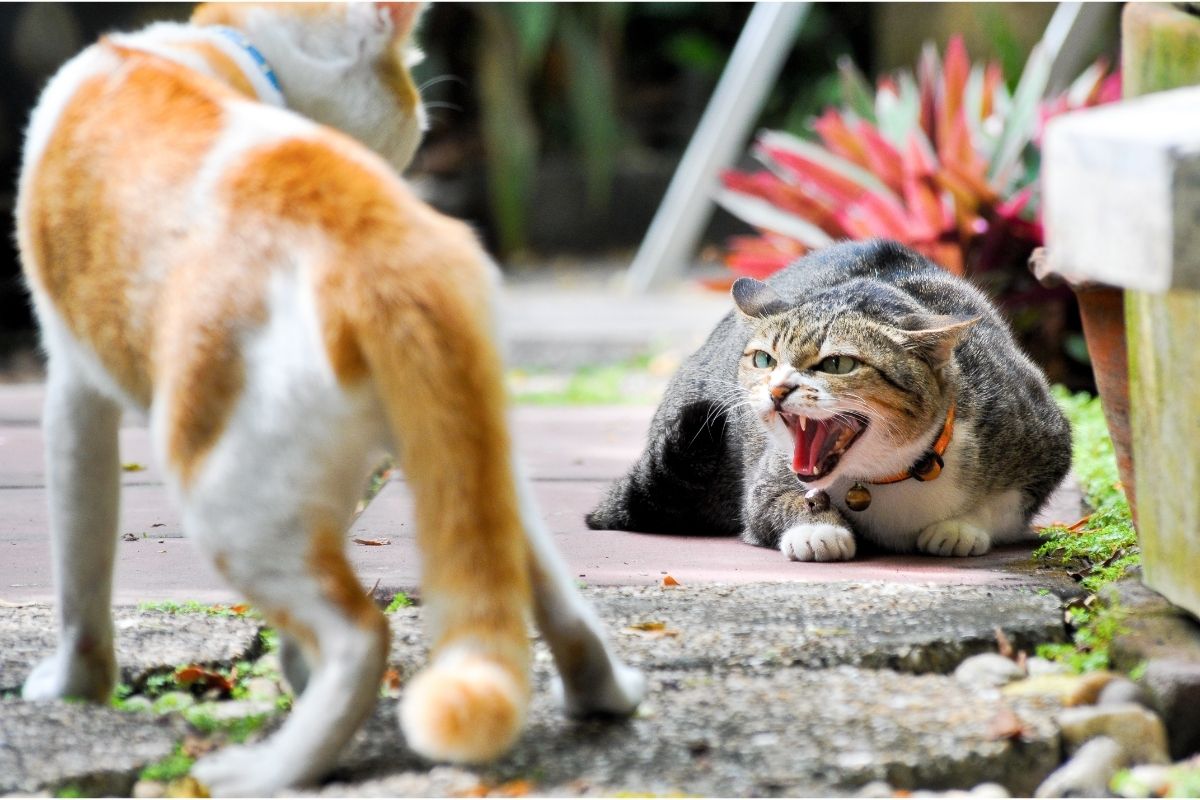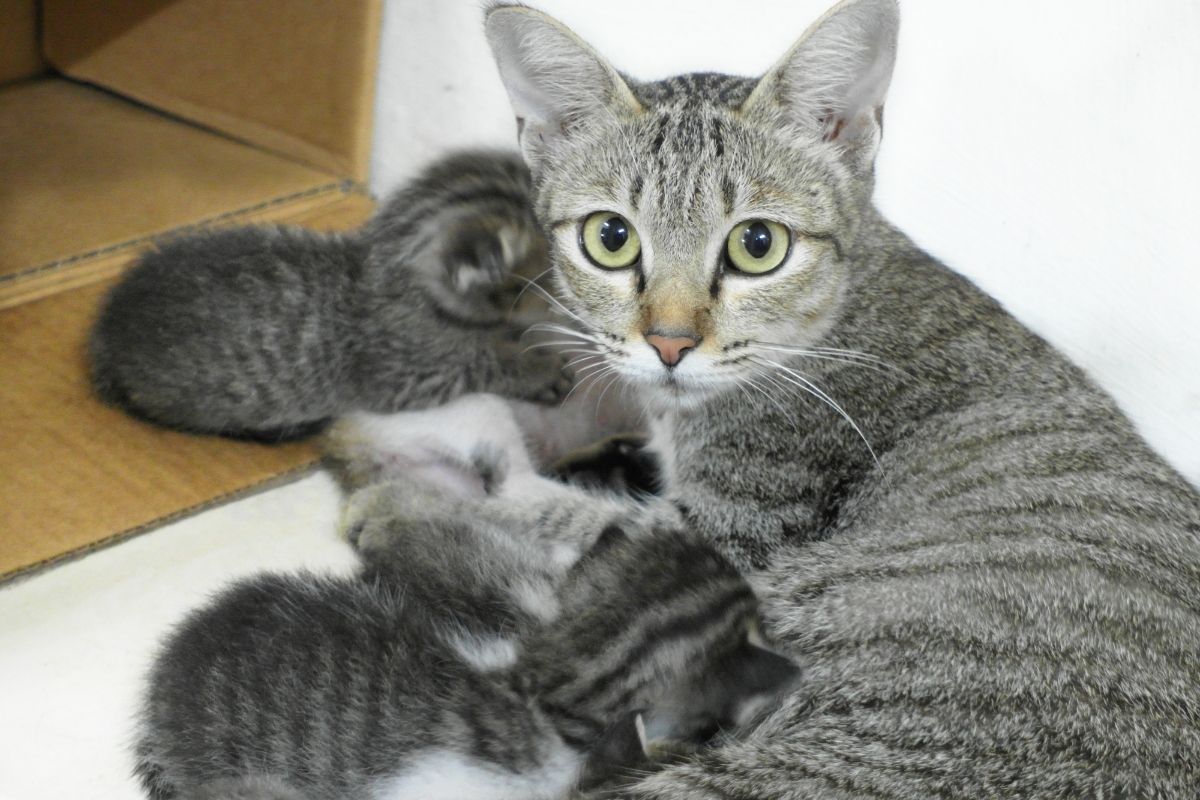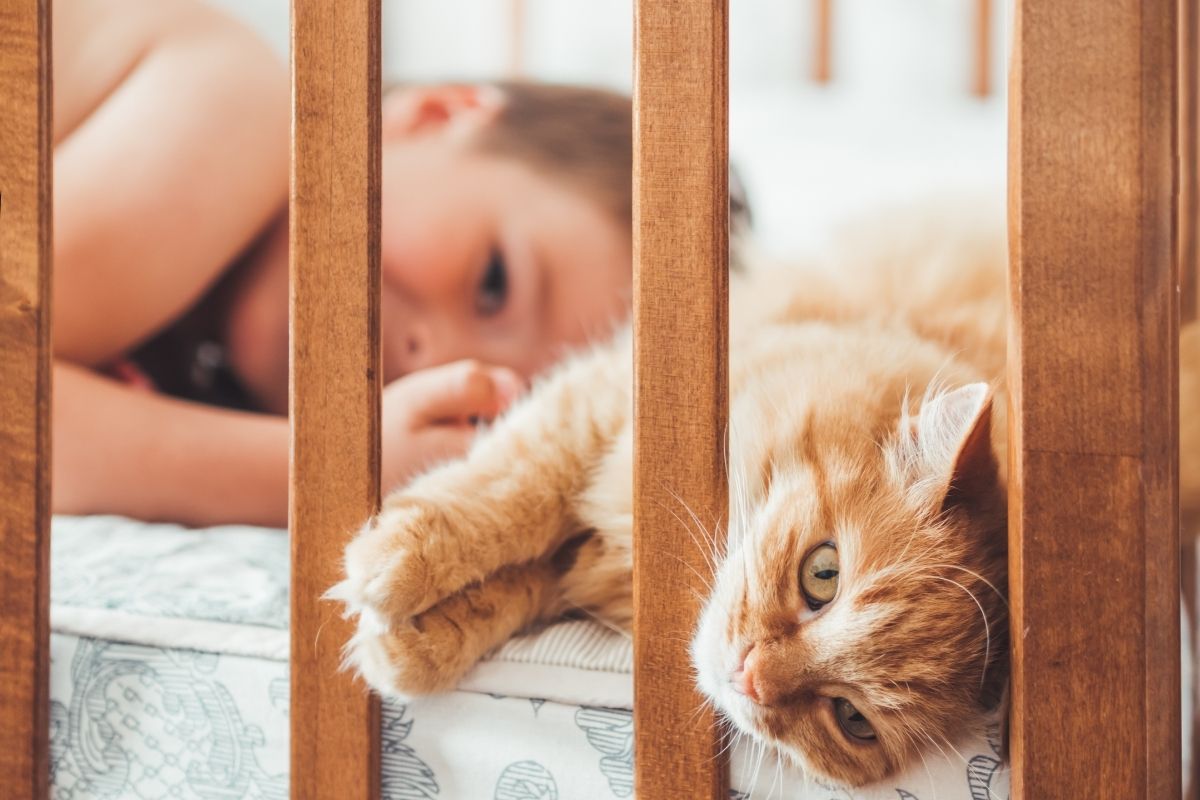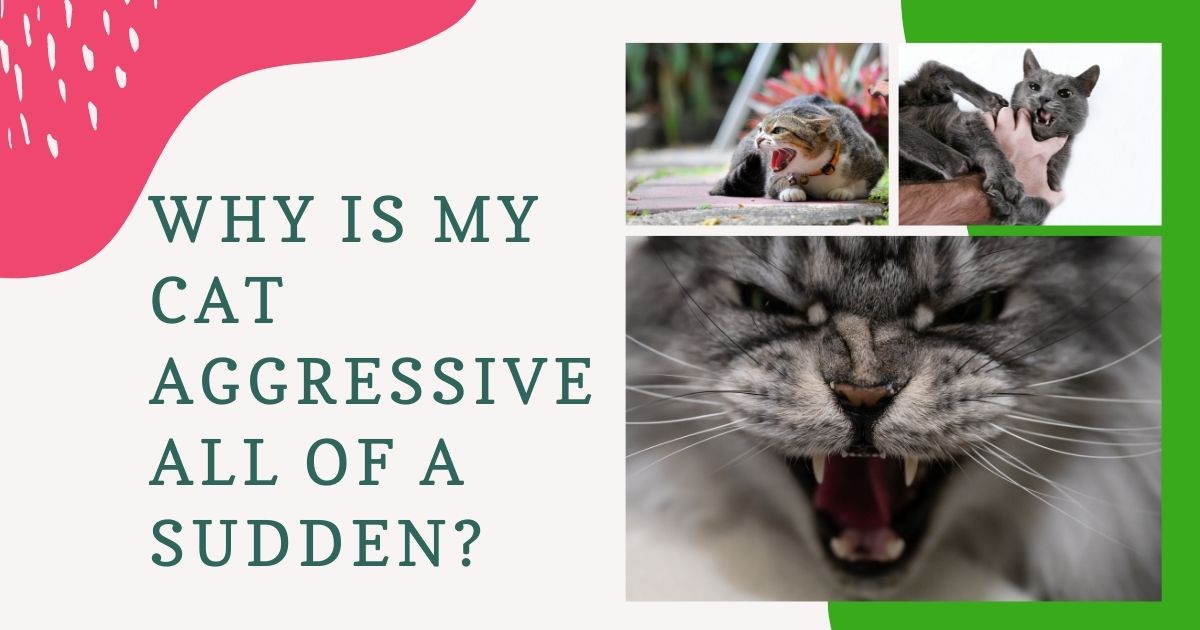Are Cats Territorial?
It can be difficult to process when your beloved cat suddenly displays signs of aggression towards you or others, so we can help assess and answer the question; why is my cat aggressive all of a sudden?
Cats can become territorial, and display territorial aggression towards an animal (usually another cat) or human they feel is invading their territory. If your cat has suddenly become aggressive, you should investigate their current living situation and if there have been any changes that may have triggered this response.
Some examples of situational changes that would cause territorial aggression include a new person or pet in the house, a new baby, moving to a new home, their private area on the home being moved or disrupted, or another cat in the area.

The General Principles for Managing an Aggressive Cat
When handling an aggressive cat, it is very important to be cautious with your response, as sometimes the way an owner deals with their aggressive cat can exacerbate their aggression.
It is essential to research and try to understand why your cat is becoming aggressive and how you can help them. Just because your cat shows aggression, it doesn’t mean they are a bad cat. They may simply be unable to cope with their fear, confusion, or stress without becoming aggressive.
If you put in the time and effort to get to the route of the aggressive behavior and begin to treat it safely, you will see a vast improvement in the quality of life of your cat. You will also strengthen your relationship with them. There are several approaches that we would recommend to handling an aggressive feline at home.
There are different types of aggression that cats can display, and in some cases, a cat may display more than one type at a time. Here are some general principles for managing all types of feline aggression:
- Physical or aggressive punishment can worsen the cat’s aggression, as they will become more anxious or fearful.
- Early intervention is the most effective way to handle their behavior issues.
- Avoid stressful situations for your cat that you know will make them aggressive.
- Positive reinforcement through food and treats is very effective in rewarding non-aggressive behavior.
- Seek medical or professional intervention if the techniques you are trying at home are unsuccessful.
- If you are dealing with inter-cat aggression, separate them from each other and slowly reintroduce them with positive reinforcement.
- If using medications or calming supplements, you should also be combining this with behavioral and environmental changes and training.
Types of Aggression in Cats
Fear Aggression
This is a very common form of aggression and can be characterized by a cat encountering a new noise, animal, person, or unpleasant experience. In addition, it can be an experience that left a negative impact on your cat, such as a vet visit.
Your cat may show its fear-caused aggression by hissing, crouching to the ground with its tail tucked beneath the stomach, flattened ears, and the fur standing on end. You should not try to console your aggressive cat, but at the same time, do not show fear or retreat, as both instances may reinforce their behavior.
Not giving your cat attention is the best way to handle a cat displaying aggressive tendencies. You should also try to avoid the situation that your cat is fearful of in the future. However, we understand that you cannot always avoid these situations.
You should begin desensitizing your cat to the fearful situation gradually. You can do this by slowly exposing the cat to the stimulus from a distance and using positive reinforcement to reward their non-aggressive behavior.
If your cat is particularly frightened of something such as a vet visit that cannot be avoided, you may seek veterinary assistance to use calming medication for these occasions.
Try to get your cat used to their carrier by leaving it out around the home and putting treats inside it for your cat to climb into themselves. Unfortunately, we often only bring out the carrier at the time of the vet visit; this induces a great fear in getting into the carrier for your cat.
Petting-Induced Aggression
We are still not 100% sure why many cats display aggression when being petted. Still, behavior experts have warranted guesses that the cat may be attempting to control when the petting ends, or they become overstimulated by too much petting.
Unpleasant physical interactions with your cat, such as bathing, grooming, and handling, may also cause this form of aggression. Signs of this form of aggression may include tail lashing, ears flattened and dilated pupils.
To handle this form of aggression, you may try lightly petting or handling and then providing positive reinforcement with treats or food. This may desensitize them to being pet or handled by you over time, and you can gradually increase the periods that you pet them. Then, if you are faced with any aggression, simply stop petting and allow them to calm down on their own.
It is essential to avoid negative reinforcement (especially physical), spontaneous petting, and handling (especially handling the cat while it’s eating). In addition, if your cat displays any signs of petting-induced aggression, it is essential to inform any visitors to the house and never leave them alone with small children.
Redirected Aggression
Your cat may be responding to some form of environmental stimulus that they cannot directly display aggression to, so they may redirect their behavior towards another animal or a human. An example of this is hearing a loud noise or seeing something outside that startled them.
If your cat is particularly excitable to environmental stimulation, you should avoid exposure to these situations. For example, you can use curtains or blinds to stop them from looking outside or play relaxing classical music to distract from unexpected noises.
Pain-Induced Aggression
One of the most common reasons for a cat displaying sudden aggression may be that they are in physical pain and want to avoid any interactions that increase their pain. For example, you may be trying to pick your cat, who is experiencing abdominal pain, up and be met with aggression, such as hissing, scratching, or biting, to prevent you from causing them pain.
If your cat is showing signs of pain when touched in a certain area, you should avoid handling them in this way and seek medical attention. Unfortunately, some cats may remember the pain of being handled in this way and keep displaying aggressive behavior if handled, even if the pain has subsided.
Status-Induced Aggression
A cat may display aggressive tendencies by blocking doorways with their bodies or swatting at humans or other pets. This can often be them trying to establish social dominance over humans or animals.
You should try to completely ignore a cat with this behavior. Any attention displayed to them while in this mood will reinforce their aggressive behavior. When your cat returns to its usual stance and behavior, you may reward them with treats and attention.
Territorial Aggression
A cat can be very possessive over its territory and feel the need to establish its territory and defend it from other animals or people they believe pose a threat. This form of aggression can show itself in the form of chasing, attacking, and swatting the target.
Territorial aggression can even develop when an animal or person who the cat previously accepted leaves for some time and returns. If your cat has territorial aggression, you should go as slow as possible with introductions and reintroductions of people or animals.
If the problem is another cat, you should keep them completely separate and gradually introduce each other with short supervised visits from a safe distance (ideally with harnesses to avoid unwanted aggressive interactions).
You must remember to never physically interrupt cats fighting, as this can lead to serious injury. Rather than using your body to separate them, you may use something like cardboard or plastic sheets to separate them.
You can continue this process, gradually allowing them to get closer until they are comfortable enough to be sharing the same space again. Once they are comfortable with each other while being unrestrained, you can begin feeding in the same room again. Take this process as slow as you need to, and it can take several months to rebuild or form a bond between territorial cats.
In some cases, your veterinarian may prescribe medications to your cat or cats to aid the process and help them to calm down. This can also be assisted with pheromone sprays and adaptor plugins.
Maternal Aggression
This type of feline aggression is easy to diagnose, as you will be able to tell if your cat is being aggressive due to protecting her kittens. As cute as the new kittens may be, you should avoid unwanted visitors to keep the mother and kittens in a calm, quiet, and safe environment.
If the queen starts displaying aggressive signs towards you, simply avoid contact with her and the kittens until the aggression subsides. This type of aggression will generally disappear as the kittens become more independent.

Inter-cat Aggression
The most common form of inter-cat aggression is typically between male cats approaching social maturity (about two to four years of age). Female cats are less likely to become aggressive in this manner.
Suppose your male or female cat is displaying aggressive behavior to other cats. In that case, you should seriously consider neutering or spaying them to address the aggression that may be caused by their sexual hormones.
If your cat does not calm down after having surgery, you should follow the rules outlined for treating territorial aggression.
Why is my Cat Aggressive all of a Sudden? The Causes
The most critical first step to take when your cat suddenly begins displaying aggression is to visit your veterinarian. Underlying pain and medical issues must be ruled out before investigating other treatments for aggression. Your cat may be trying to tell you something significant about their health, and you should not ignore them.
If the veterinarian deems them healthy, you can request a referral to a cat behaviorist to help you get to the route of their aggression and advise how to resolve the issue at home.
Do your research and become familiar with the signs that signal the beginning of aggressive behavior in your cat. You may be able to diffuse and avoid violent situations altogether. Cats usually value their calm, quiet, alone time very highly, and allowing them to calm down in their own space is the key to treating sudden aggression.
What Does Aggression in Cats Look Like?
Many owners claim that their cat has become violent out of the blue. However, this may be because you do not fully understand the subtle body language changes in felines that tell you they are unhappy.
The posture of a cat is so important to consider when looking for signs of aggression or fear. Some defensive positions that may indicate oncoming aggression include:
- Crouching
- Flattened ears
- Making their appearance smaller
- Tucked head
- Hissing
- Raised hackles
There are also offensive positions that a cat may adapt to look intimidating; they include:
- Upright ears
- Growling
- Staring
- Stiff tail
- Moving towards you
- Hackles raised
What Should I do When I Encounter Unprovoked Aggression in Cats?
If your cat is displaying early signs of aggression or becoming actively aggressive towards you, the most important thing you can do is avoid the interaction altogether. You should simply leave calmly and without showing fear or stress and allow the cat to calm down on its own.
If you are witnessing the early signs of aggression, you should leave the cat alone before the situation escalates and turns into a violent situation. Aggressive cats can cause severe damage to their claws or teeth, so do not put yourself at risk by interfering with them.
5 Tips to Calm an Aggressive Cat
Consult a Veterinarian
Your cat may be becoming aggressive due to an underlying health issue or general pain, so it is wise to rule out any health issues before treating your cat for aggression. Your veterinarian may do a physical exam and/or diagnostics to investigate if pain or illness is the cause of their aggressive tendencies.
Suppose the vet is unable to diagnose your cat with a medical issue. In that case, they can also refer you to a cat behaviorist or, in extreme cases, prescribe some calming medications which may help lessen the aggressive behavior at home. In addition, there are over-the-counter calming supplements that go in their food that can also help create a calm environment.
Provide a Safe Space for Your Cat
Your cat may be acting out of aggression due to feeling unsafe and unsettled in their home. It is essential for a cat to have a private area to feel calm and safe. Try not to disrupt or move their safe space, whether it is a comfortable armchair or their bed, in a quiet corner of the room.
You can also purchase calming pheromone adaptors and sprays for the home to help soothe your angry or stressed feline friend. Try to ensure they cannot be disrupted too much in this space by loud noises or other pets/children. Cat condos are a great option as they can climb into high areas where they cannot be disturbed by others.
Do Not React Aggressively
If you react to your cat’s aggression by matching their energy and yelling, this may worsen their symptoms and break down the bond between you and your cat. Instead, you should try to react as calmly as possible, strengthen your bond when they are not having an aggressive episode and remove yourself from the situation when they are becoming aggressive towards you.
Diffuse Fights in Multiple Cat Households
If you have many cats at home who are becoming aggressive to each other, you may need to put preventative measures in place to reduce fights. Calming pheromone plug-in adaptors and sprays can help in these households.
It is important to remember that un-neutered cats will be more prone to aggressive tendencies, and this may be something you want to consider, especially with multiple cats in a home. Try to provide your cats with their own private safe spaces to escape when they want to be alone.
Keep Small Children Away
Your cat may be gentle and sweet with your child; however, things can go dramatically south when a cat with aggressive behavior is triggered by something such as being pat the wrong way or accidental injury.
It is always advisable never to leave children to interact with animals unsupervised, even if the animal is good-natured.

Conclusion
It is essential to rule out medical issues or pain that could be causing this sudden onset of aggression, as many cats turn to aggression when they feel unwell.
If you have ruled out health issues and are dealing with an aggressive cat, always remember to have patience, understanding and give your cat plenty of space and time to themselves to process their emotions. Determining the underlying issue that has caused their aggression is the key to identifying the problem and building a path to recovery.


1 thought on “Why Is My Cat Aggressive All Of A Sudden?”
Comments are closed.